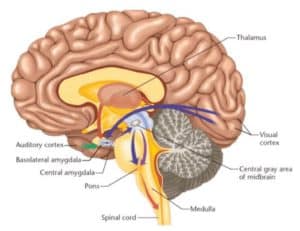
The amygdala is thought to be a part of the limbic system within the brain, which is responsible for emotions, survival instincts, and memory.
In his workshops Dr Tony Attwood discusses the studies that have found that the amygdala is enlarged in children with autism spectrum disorder (ASD). He believes this is why we see children not being able to regulate behaviour, unusual reactions to pain and more.
Amygdala – limbic structure involved in many brain functions, including emotion, learning and memory. It is part of a system that processes ‘reflexive’ emotions like fear and anxiety.
What is known about the amygdala is that it has a dual sensory input system. The amygdala is specialised for reacting to stimuli and triggering a physiological response, a process that would be described as the ‘emotion’ of fear. Once an emotion has been turned on, it is difficult for the cortex to turn it off.
Imagine you are in a heightened state of fear. Would you want routines, pre-warnings about change? Would you over react to noises, light, touch? Would you want to control your environment and need time on your own to calm from the increased anxiety?
Many children with ASD can become sensory overloaded or have another diagnosis of SPD (Sensory Processing Disorder).
Sensory overload can look like:
- Refusing activities
- Racing heartbeat
- Hysterical crying
- Covering ears
- Hiding or running away
- Extreme sensitivity to sound, light, etc.
Occupational Therapists often introduce a sensory diet which aims to enhance the child’s efferent and appropriate response to sensory stimulation. In my experience, home and school/preschool also need to encourage and support the child to engage in a range of sensory activities. When children play outside, climb on equipment, do puzzles, paintings etc. they are developing essential sensory, perceptual and visual skills. Many children with ASD and SPD need to be encouraged to try a range of these activities as we know they are a vital part of a child’s physical, emotional and academic success. There is a great new book full of wonderful activities to help children develop, learn and grow called The In-Sync Activity Card Book..


 For all orders outside Australia please email
For all orders outside Australia please email 